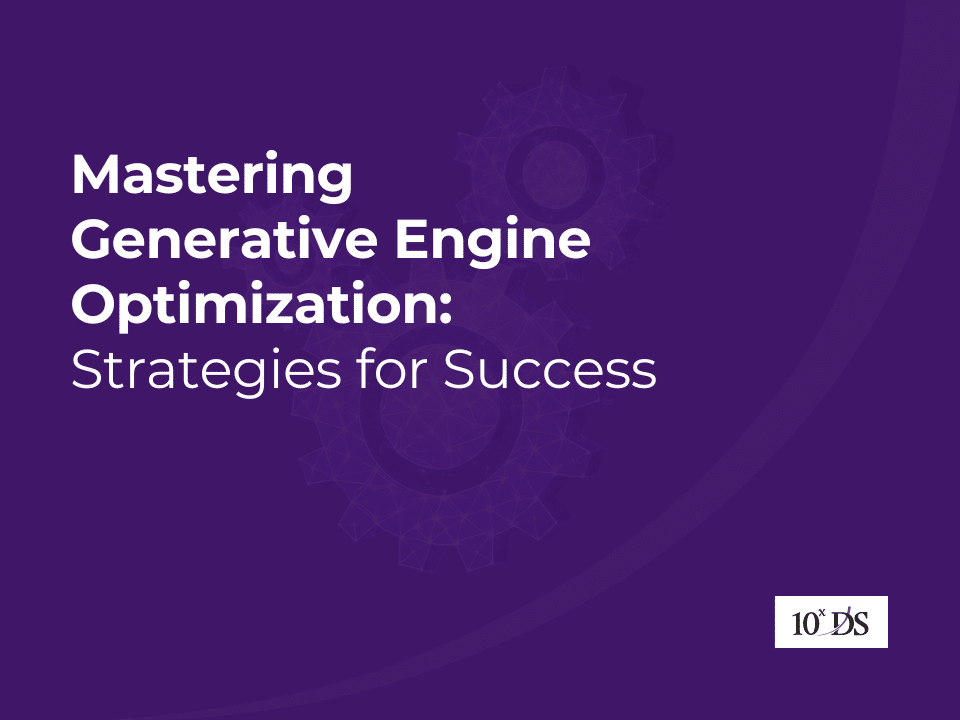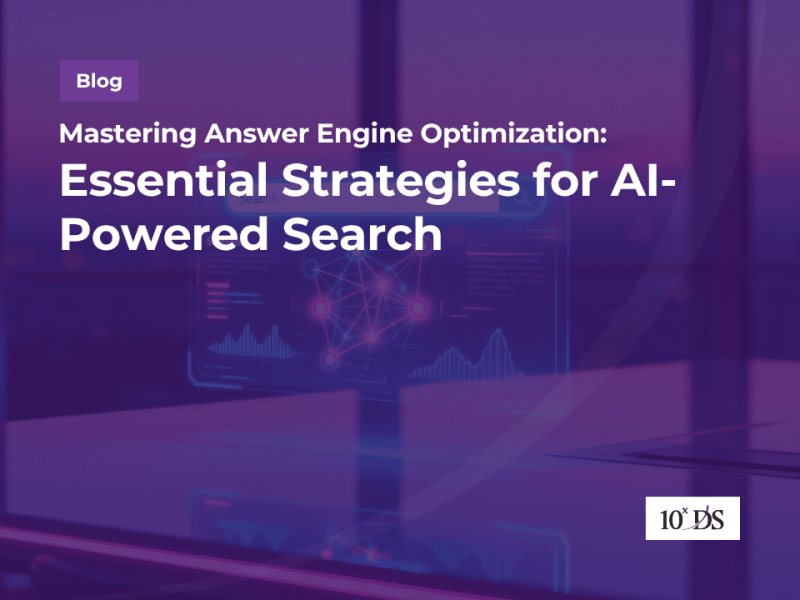
Mastering Generative Engine Optimization: Strategies for Success
In today’s digital landscape, businesses and creators are witnessing a fundamental shift in how users find, consume, and interact with information. Traditional search engine optimization (SEO) is no longer the only path to visibility. The rise of AI-driven search tools, such as generative engines like ChatGPT, Google’s Search Generative Experience (SGE), and Perplexity, has paved the way for a new discipline: Generative Engine Optimization (GEO). Achieving in this space means rethinking how content is created, structured, and delivered to align with how generative AI engines source, summarize, and recommend information.
This blog will explore what GEO is, why it matters in the evolving digital ecosystem, and practical strategies for GEO that can help you stand out in an AI-driven world.
What is GEO?
To understand how to succeed in this emerging field, the first step is grasping clarity on the answer to “what is GEO?”. Generative Engine Optimization refers to the practice of optimizing content specifically for generative AI engines. Unlike traditional SEO, which focuses on ranking high on search engine results pages (SERPs), GEO is about ensuring your content is discoverable, reliable, and usable within AI-generated responses.
So, what is GEO in practical terms? It’s a set of strategies that help your content stand out in AI outputs, ensuring it’s cited, quoted, or summarized favourably. This optimization is crucial because generative engines are reducing clicks to original sites by providing direct answers, potentially slashing organic traffic for unprepared publishers.
Delving deeper, it is an evolution of digital marketing that emphasizes human-like qualities in content: persuasiveness, data-backed claims, and seamless readability. As AI tools become the primary information gatekeepers, understanding GEO means recognizing that visibility now depends on how well your content aligns with AI preferences for credible, engaging narratives. In essence, GEO bridges the gap between human intent and machine interpretation, making it indispensable for future-proofing your online presence.
Why GEO Matters?
According to a study by researchers from Princeton University, Georgia Tech, and IIT Delhi, deploying Generative Engine Optimization (GEO) techniques can increase visibility in AI-generated responses by up to 40%. This move toward generative search has profound implications for businesses, marketers, and content creators. Here’s why:
- Changing Search Behaviour: Users are increasingly turning to AI tools for quick, conversational answers instead of sifting through links. Being visible within AI-generated responses means staying relevant to how people search today.
- Reduced Click-Through Opportunities: With generative engines answering directly in their interface, fewer users may click on websites. GEO ensures your brand isn’t left out of the conversation.
- Authority and Trust: AI models prioritize content that is credible, well-structured, and comprehensive. Gaining in GEO builds authority not only in AI engines but also in users’ perceptions.
- Competitive Edge: Businesses that adapt early to GEO strategies gain a significant advantage as competitors lag behind.
Top Advantages of Generative Engine Optimization (GEO)
- Increased Visibility in AI Answers
Instead of just ranking on traditional search engine results, GEO helps your content appear directly within AI-generated answers—putting your brand at the centre of user conversations. - Higher Engagement Without Clicks
Even if users don’t visit your website, being cited in AI responses keeps your brand visible, improving recall and influence. - Future-Proofing Digital Strategy
As AI-driven search becomes the new norm, GEO ensures your content adapts to evolving user behaviours and stays relevant long-term. - Cross-Platform Consistency
GEO encourages brands to maintain accurate, structured, and updated content across websites, social platforms, and public databases, strengthening overall brand presence. - Improved Content Quality
To succeed in GEO, content needs to be comprehensive, transparent, and user-centric—raising the overall standard of your digital assets. - Better Alignment with Natural Language Queries
Generative engines thrive on conversational search. GEO ensures your content matches how people naturally ask questions, making it more discoverable.
Strategies for GEO
Now that we’ve explored what GEO is, the next step is to focus on actionable steps to succeed. Below are key strategies for GEO that can help businesses and creators secure their place in the generative AI ecosystem.
1. Focus on Authoritative Content
Generative engines give higher priority to information from sources with established authority. To build this authority, it is important to publish in-depth, research-backed content that demonstrates expertise and reliability. Supporting the content with references, citations, and credible sources further enhances its trustworthiness. Additionally, highlighting the author’s credentials, expertise, and the reputation of the organization helps establish credibility and ensures that the information is perceived as authoritative.
2. Optimize for Conversational Queries
Generative engines excel at processing natural language, so it’s essential to create content that aligns with this strength. One effective approach is to develop content that answers questions in conversational formats, such as FAQs and Q&A sections, making it easier for engines to match user intent. Incorporating long-tail, natural language keywords further improves relevance and discoverability. Finally, writing in a clear, reader-friendly tone ensures that the content is both accessible and engaging for the audience.
3. Structured and Machine-Readable Data
AI engines rely heavily on structured data to extract insights, which makes it important to present information in a clear and organized manner. Using schema markup to highlight entities, reviews, FAQs, and product details helps engines better interpret and categorize content. Breaking content into digestible sections with headings and bullet points further improves readability and structure. Additionally, incorporating tables, charts, and lists makes the content more scannable, enhancing both user experience and machine understanding.
4. Consistency Across Platforms
AI models pull information from a wide range of sources, including websites, social media, and public databases, making consistency crucial. To ensure accuracy and trust, it’s important to maintain consistent messaging and information across all platforms. Brand details such as contact information, product descriptions, and service lists should be kept up to date and aligned everywhere, so both users and AI systems can rely on the information with confidence.
5. Freshness and Updates
Generative engines place high value on current, up-to-date information, which makes regular content maintenance essential. Refreshing website content frequently helps keep it relevant and engaging, while updating statistics, facts, and product details ensures accuracy and credibility. Maintaining a content calendar for ongoing updates provides a structured approach, allowing you to consistently deliver fresh information that both users and AI systems can trust.
6. Multimedia and Multi-Format Content
AI engines don’t just parse text—they also analyse multimedia, making it important to diversify the content you provide. Incorporating videos, podcasts, infographics, and images can enrich the user experience while boosting discoverability. To maximize impact, include transcripts and detailed descriptions for multimedia elements, ensuring that the information is both machine-readable and user-friendly. Additionally, using accessibility features such as alt text not only supports inclusivity but also enhances how AI engines interpret and surface your content.
7. Brand Mentions and Backlinks
Just as with SEO, brand credibility plays a vital role in how AI engines evaluate and prioritize content. Securing backlinks from authoritative sites strengthens trust and signals reliability. Encouraging mentions of your brand in industry news, forums, and reports further enhances visibility and recognition. Additionally, building thought leadership by contributing to guest blogs and reputable publications positions your brand as an expert voice, reinforcing credibility across platforms.
8. Optimize for Trust and Transparency
Generative engines prioritize content that demonstrates transparency, making it important to clearly communicate how information is sourced and presented. Disclosing sources and data collection methods helps establish trust and credibility, while ensuring compliance with data privacy regulations safeguards both users and your brand. Where appropriate, using clear disclaimers further reinforces openness and accountability, creating content that is both trustworthy and reliable.
9. Community and Engagement
Generative AI systems also capture valuable signals from social and community activity, making active engagement essential. Participating in forums, Q&A platforms, and social media helps strengthen visibility and trust. Building communities around your niche fosters deeper connections and brand loyalty, while encouraging user-generated content and reviews adds authenticity and credibility. Together, these efforts create a strong digital presence that both audiences and AI systems recognize.
10. Technical Performance
While GEO emphasizes content quality, the technical aspects of your website still play a critical role in how AI systems interpret and prioritize it. Ensuring fast loading speeds and mobile responsiveness improves user experience and accessibility across devices. Strengthening site security with HTTPS builds trust and protects user data. Additionally, maintaining clean, error-free code allows AI engines to parse and process your content more efficiently, increasing the likelihood of higher visibility and credibility.
Measuring Success in GEO
Success in GEO looks different from traditional SEO. Metrics to track include:
- Inclusion Rate: How often your content appears in AI-generated responses.
- Brand Mentions in AI Outputs: Whether generative engines reference your business.
- Engagement Beyond Clicks: How users interact with your brand after AI exposure.
- Relevance and Accuracy: How faithfully AI engines represent your content.
Tools for tracking GEO are still evolving, but monitoring AI-generated answers for your niche queries can provide insights.
Future of GEO
Looking ahead, the future of GEO promises to reshape digital visibility as AI systems grow more sophisticated. As generative engines integrate deeper multimodal capabilities—blending text, images, and even real-time data—content creators will need to adapt by producing richer, more interactive content formats. Advances in AI personalization mean GEO strategies will increasingly focus on hyper-targeted, context-aware optimization, leveraging user behaviour data to tailor responses. Moreover, as open-source AI models proliferate, GEO will demand agility to account for varying algorithms across platforms. Staying ahead will require continuous experimentation, investment in structured data, and alignment with emerging standards like voice and visual search, ensuring content remains discoverable in an AI-driven world.
Conclusion
Generative Engine Optimization is not just a trend—it’s the next chapter of digital visibility. Understanding what GEO is, is the foundation, but applying effective strategies for GEO ensures you remain competitive in an AI-first search landscape. By creating authoritative, structured, and user-centric content, you can position your brand to thrive in the era of generative search.
To prevail in GEO, think beyond traditional SEO metrics. Instead of only focusing on page rankings, prioritize being part of the actual answers generative engines deliver to users. This requires a shift in mindset—from chasing clicks to building trust, authority, and reliability. The brands that provide consistent, transparent, and high-quality information will become the voices that AI engines amplify.
In this new landscape, businesses that adapt quickly will hold the competitive edge. The question isn’t whether GEO will shape the future of search—it’s how prepared you are to embrace it now and lead the way.
The future of digital visibility will be defined not just by who shows up first on a search results page, but by who gets cited, referenced, and trusted within AI-powered answers. GEO is your chance to future-proof your strategy, ensuring that no matter how search evolves, your brand continues to be seen, trusted, and chosen.


